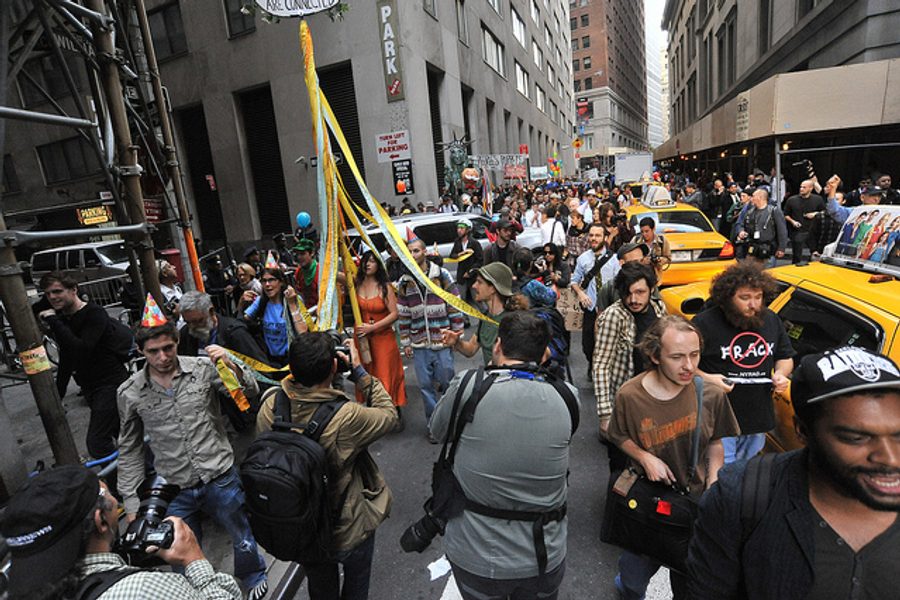
Yesterday morning, while I was in the Financial District reporting on the actions marking Occupy Wall Street’s first anniversary, I was surprised to see the mainstream media already filing copy calling the movement dead and buried.
Hundreds were still demonstrating, many of them arrested without cause; whole streets of the Financial District were blocked off. The spectacle was loud and visible and still very much in-progress. Yet still the reports streamed in: USA Today asked if the movement was spent, while TIME went out and just said it was.
Either these journalists are preternaturally quick writers or they had already constructed a narrative of failure for the protests before they had even begun.
Andrew Ross Sorkin, who lamented that “…Occupy Wall Street, which began with a small band of passionate intellectuals, had been hijacked by misfits and vagabonds looking for food and shelter,” seemed to think Elliott Spitzer was the person to ask to understand why the movement had “fallen apart.”
It’s clear that these commentators lack a basic understanding of Occupy’s politics, history and origins, and are in no position to judge the movement’s trajectory or write its obituary.
The demonstration was relatively small in number, down from the heights of last fall. But tactically, organizers made important adjustments. The small roving bands of protesters were harder to quarantine than the November 17 actions and reminded me of the impromptu style of protest in Montreal.
But much of the disruption to Lower Manhattan’s daily grind occurred as a result of a massive and rowdy police presence. Journalist John Knefel, for example, was simply grabbed off the sidewalk along with several others. There was no provocation.
I saw many arrests in this mold. It wasn’t that the police were out of control – they were executing their own strategy to perfection. Protests, even relatively small peaceful ones, are smothered in their infancy. The legal consequences can be dealt with after.
As I wrote during the Democratic National Convention earlier this month:
Seattle’s 1999 World Trade Summit and the 2004 Republican National Convention in New York are prominent in the minds of authorities. Protesters ran amok in Seattle, but in New York police used new powers developed in the context of post-9/11 counter-terrorism to maintain order through mass arrests. An unprecedented number, almost 2,000, were arrested, but 90 percent of these charges were eventually dropped.
The importance of police repression in limiting the size and scope of yesterday’s protests cannot be understated. From my own delightfully subjective personal experience, not that the mainstream “news reporters” weren’t delightfully subjective in their own way, I saw the actions as a success. It rekindled the memory of Occupy’s early days and perhaps can serve as a stepping stone to a wider resurgence.
Broader questions still remain, however.
Occupy has been tactically adaptive, owing in large part to a creative well-spring within the anarchist movement. The resurgence in militance, the reminder of the rich tradition of American extra-parliamentary politics, has certainly had its effect. The Chicago Teachers Union strike is part of a climate that benefited from Occupy. Yet its failure on wider strategic question and its inability to translate last fall’s energy into broader and more sustained articulations remains a problem. A problem that unsurpisingly reflects historical weaknesses within the anarchist movement.
It’s a debate that goes beyond the scope of one blog post. But don’t expect to read about possible solutions in the Associated Press and don’t count Occupy out just yet.
Bhaskar Sunkara is the president of The Nation magazine and the founding editor of Jacobin. Follow him on Twitter: @sunraysunray.




